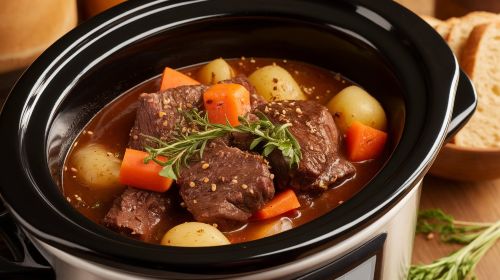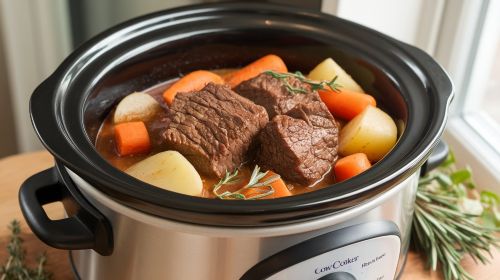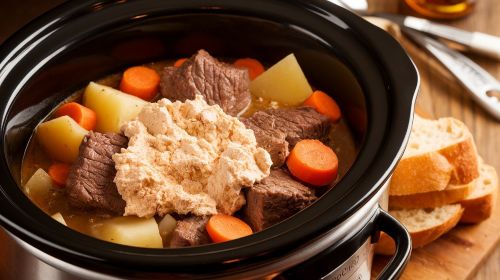Best Slow Cooker Beef Stews and Soups to Try This Winter
Winter is a season of comfort. The air gets crisp. The days grow shorter. We find ourselves craving warmth, coziness, and meals that feel like a hug in a bowl. Nothing delivers on this promise quite like a slow cooker. This countertop marvel is your secret weapon for a season of delicious, hassle-free cooking. And at the heart of winter cuisine is a rich, savory beef stew or soup.
Imagine coming home after a long day. The house is filled with the incredible aroma of beef, herbs, and vegetables. They have been simmering slowly for hours. The meat is so tender it falls apart with a gentle touch. The broth is deep, complex, and utterly satisfying. This isn’t a fantasy. This is the reality of slow cooking.
This guide is your ultimate resource for mastering slow cooker beef stews and soups. We will cover everything. You will learn the best cuts of beef to use. You will get a foolproof classic recipe. We will explore exciting variations from around the world. We will share pro tips that elevate your dish from good to unforgettable. At FastFlavorz, we believe amazing food should be accessible to everyone. Your slow cooker is the key.
Let’s dive in and make this your most delicious winter yet.
The Magic of Low and Slow: Why Use a Slow Cooker?
Before we get to the recipes, let’s understand why the slow cooker is the perfect tool for the job. Cooking beef low and slow is a time-honored technique. A slow cooker simply modernizes it. It makes the process incredibly easy and hands-off.
The magic lies in how it handles tougher cuts of beef. These cuts are full of connective tissue, mainly collagen. When cooked quickly at high heat, this tissue becomes tough and chewy. But when cooked slowly at a low, consistent temperature, a wonderful transformation happens. The collagen melts away. It turns into rich, succulent gelatin. This gelatin infuses the broth with body and flavor. It also makes the meat incredibly moist and tender.
The benefits are clear:
- Incredible Flavor: Simmering for hours allows the flavors of the beef, vegetables, and seasonings to meld together. This creates a depth you can’t rush.
- Unbeatable Tenderness: Even the most affordable cuts of beef become fall-apart-tender.
- Supreme Convenience: The “set it and forget it” nature of a slow cooker is a game-changer. You can prep in the morning and have dinner ready when you get home.
- Energy Efficiency: A slow cooker uses significantly less energy than a conventional oven.
Choosing Your Champion: The Best Cuts of Beef for Stew
The cut of beef you choose is the single most important decision you’ll make. Choosing the wrong cut can lead to dry, tough, and disappointing results. You want cuts that are rich in fat and connective tissue. These are typically the more affordable options, which is a fantastic bonus.
Avoid lean and expensive cuts like sirloin, tenderloin, or filet mignon. They lack the collagen and fat needed for slow cooking. They will simply dry out and become tough over a long cooking time.
Here is a table of the best cuts of beef for your slow cooker.
| Cut of Beef | Description | Why It Works Well in a Slow Cooker |
|---|---|---|
| Chuck Roast | The gold standard. From the shoulder, it has a perfect balance of meat, fat, and collagen. Often sold as “stew meat.” | It breaks down beautifully over several hours, becoming incredibly tender and flavorful. It’s a reliable and widely available choice. |
| Beef Shank | A cross-section of the leg bone, surrounded by meat. The bone contains marrow, which adds incredible richness. | The marrow melts into the broth, creating an unparalleled depth of flavor and a silky texture. The meat becomes very tender. |
| Brisket (Point) | From the chest of the cow. The “point” cut is fattier than the “flat” and is ideal for slow cooking. | It has a high fat content that renders down, keeping the meat moist and adding immense flavor to the stew. |
| Short Ribs | Can be bone-in or boneless. They are layers of meat and fat, making them exceptionally rich. | The meat becomes so tender it literally falls off the bone. They create a luxurious and deeply beefy broth. |
The Unforgettable Classic: Perfect Slow Cooker Beef Stew

This recipe is your foundation. It’s a traditional, hearty beef stew that is guaranteed to please. Once you master this, you can experiment with confidence. We have broken it down into simple, easy-to-follow steps.
“Good food is the foundation of genuine happiness.” – Auguste Escoffier
This stew is a prime example of that philosophy. Simple ingredients, cooked with care, result in pure joy.
Ingredients
- 2.5 lbs beef chuck roast, cut into 1.5-inch cubes
- Salt and black pepper
- 3 tablespoons all-purpose flour
- 3 tablespoons olive oil, divided
- 1 large yellow onion, chopped
- 4 cloves garlic, minced
- 2 large carrots, peeled and cut into 1-inch chunks
- 3 celery stalks, cut into 1-inch chunks
- 1 lb baby potatoes, halved
- 4 cups beef broth, preferably low-sodium
- 1 cup dry red wine (like Cabernet Sauvignon or Merlot)
- 2 tablespoons tomato paste
- 1 tablespoon Worcestershire sauce
- 1 teaspoon dried thyme
- 2 bay leaves
- 1 cup frozen peas
- 2 tablespoons fresh parsley, chopped (for garnish)
Instructions
- Prepare the Beef. Pat your beef cubes dry with paper towels. This is crucial for getting a good sear. Season them generously with salt and pepper. Place the flour in a shallow bowl and toss the beef cubes to lightly coat them.
- Sear the Beef. This is the most important step for flavor. Do not skip it. Heat 2 tablespoons of olive oil in a large skillet or Dutch oven over medium-high heat. Add half of the beef cubes to the pan in a single layer. Do not overcrowd the pan. Sear the beef for 2-3 minutes per side, until a deep brown crust forms. Transfer the seared beef to your slow cooker. Repeat with the remaining beef.
- Sauté the Aromatics. Reduce the heat to medium. Add the remaining 1 tablespoon of olive oil to the same skillet. Add the chopped onion, carrots, and celery. Cook for 5-7 minutes, until the onion has softened. Add the minced garlic and cook for one more minute until fragrant.
- Deglaze the Pan. Pour the red wine into the skillet. Use a wooden spoon to scrape up all the browned bits from the bottom of the pan. This is called “deglazing,” and those bits are pure flavor. Let the wine simmer for about 2 minutes, allowing it to reduce slightly.
- Combine in the Slow Cooker. Pour the wine and vegetable mixture from the skillet into the slow cooker over the beef. Add the halved potatoes, beef broth, tomato paste, Worcestershire sauce, thyme, and bay leaves. Stir everything gently to combine.
- Cook Low and Slow. Cover the slow cooker and cook on LOW for 8-10 hours or on HIGH for 4-5 hours. The LOW setting is highly recommended for the most tender meat.
- Finish the Stew. About 15 minutes before serving, stir in the frozen peas. They will cook quickly from the residual heat. Remove the bay leaves. Taste the stew and adjust seasoning with more salt and pepper if needed.
8s. Serve and Garnish. Ladle the hot stew into bowls. Garnish with fresh parsley. This adds a pop of color and fresh flavor. Serve immediately with crusty bread for dipping.

Soup’s On! Hearty Slow Cooker Beef and Vegetable Soup
While stew is thick and chunky, sometimes you crave a lighter, broth-based soup. This recipe uses a similar flavor base but results in a classic soup. It’s perfect for when you’re feeling under the weather or just want a lighter, soupy meal.
Ingredients
- 2 lbs beef chuck, cut into 1-inch cubes
- Salt and black pepper
- 2 tablespoons olive oil
- 1 large onion, diced
- 2 carrots, diced
- 2 celery stalks, diced
- 3 cloves garlic, minced
- 8 cups beef broth
- 1 (14.5 oz) can diced tomatoes, undrained
- 1 teaspoon dried oregano
- 1 bay leaf
- 1.5 cups small pasta (like ditalini or elbow macaroni) or 1 cup barley
- 1 cup frozen corn
- 1 cup green beans, trimmed and cut into 1-inch pieces
- 2 tablespoons fresh dill or parsley, chopped
Instructions
- Sear the Beef. Just like the stew, this step is vital. Season the beef with salt and pepper. Heat the olive oil in a large skillet over medium-high heat. Sear the beef in batches until browned on all sides. Transfer to the slow cooker.
- Sauté Vegetables. In the same skillet, cook the onion, carrots, and celery until softened, about 5 minutes. Add the garlic and cook for 1 more minute.
- Combine Ingredients. Transfer the vegetables to the slow cooker. Add the beef broth, diced tomatoes, oregano, and bay leaf. Stir to combine.
- Slow Cook. Cover and cook on LOW for 7-9 hours or on HIGH for 3-4 hours. The beef should be very tender.
- Add Final Ingredients. About 30-40 minutes before serving, add the pasta or barley, corn, and green beans. If using pasta, you might need to add an extra cup of water or broth as it will absorb liquid. Turn the slow cooker to HIGH.
- Finish and Serve. Once the pasta or barley is tender, your soup is ready. Remove the bay leaf. Stir in the fresh dill or parsley. Season with salt and pepper to taste and serve hot.
Global Inspirations: Take Your Stew Around the World
Once you are comfortable with the basic technique, you can explore a world of flavor. The slow cooker is a perfect vehicle for creating international dishes. Here are a few ideas to get you started.
Italian-Inspired Beef and Farro Stew
Give your stew a rustic Italian twist. This version is savory, herby, and wonderfully wholesome.
- Swap the Wine: Use a hearty Chianti or other Italian red wine.
- Add Herbs: Use 1 tablespoon of fresh rosemary and a Parmesan cheese rind in the slow cooker. The rind will melt into the broth, adding salty, umami flavor. Remove it before serving.
- Change the Veggies: Add a (28 oz) can of crushed San Marzano tomatoes.
- Use a Grain: Instead of potatoes, stir in 1 cup of farro during the last hour of cooking. It adds a wonderful chewy texture.
Mexican-Inspired “Carne Guisada”
Carne Guisada is a Latin American beef stew with a rich, spiced gravy. It’s incredibly flavorful and perfect served with rice or warm tortillas.
- Spice it Up: When you toss the beef in flour, add 1 tablespoon of chili powder and 1 teaspoon of cumin.
- Add Peppers: Sauté a diced bell pepper and a diced jalapeño along with your onions.
- Liquid Changes: Use beer (a Mexican lager) instead of red wine for deglazing. Add a small (4 oz) can of diced green chiles to the slow cooker.
- Finishing Touches: Stir in a handful of fresh chopped cilantro and a squeeze of lime juice at the end.
Asian-Inspired Spicy Beef Noodle Soup
This soup is inspired by the flavors of Chinese and Taiwanese beef noodle soups. It’s rich, complex, and deeply comforting.
- Aromatic Base: In addition to garlic, sauté 1 tablespoon of grated fresh ginger.
- Flavorful Broth: Add 1/4 cup of soy sauce, 2 tablespoons of oyster sauce, 2-3 star anise pods, and one cinnamon stick to the beef broth.
- Add Some Heat: Add 1-2 teaspoons of chili garlic sauce, or more to taste.
- Serving Style: Cook noodles separately according to package directions. To serve, place noodles in a bowl, ladle the beef and broth over the top, and garnish with chopped scallions and bok choy that you’ve quickly wilted in the hot broth.
Pro Tips for Perfect Slow Cooker Beef Dishes
Achieving slow cooker perfection involves a few key techniques. These tips will help you avoid common pitfalls and ensure your meal is a success every time.
The Golden Rule: Always Sear Your Beef
We’ve said it before, but it’s worth repeating. Searing the meat before it goes into the slow cooker is not an optional step. This process, known as the Maillard reaction, creates a deep, brown crust. This crust translates to a massive boost in flavor for the entire dish.
Layering Flavors: Don’t Just Dump and Go
A great stew is built in layers. Start by searing the meat. Then, sauté your aromatics (onion, carrot, celery, garlic) in the same pan. Deglaze the pan with wine, broth, or beer to lift all those flavorful browned bits. This thirty-minute process at the beginning makes a world of difference in the final product.
The Liquid Question: How Much is Too Much?
Slow cookers have tight-fitting lids. This means very little liquid evaporates during cooking. A common mistake is adding too much broth. For a stew, the liquid should only come about halfway up the ingredients, not cover them completely. The ingredients will release their own juices as they cook. For a soup, you can be more generous.

Thickening Your Stew: The Final Flourish
Sometimes your stew might be a bit thinner than you’d like. There are several easy ways to thicken it at the end of the cooking process.
| Thickening Method | How to Do It | Pros and Cons |
|---|---|---|
| Cornstarch Slurry | Mix 1 tablespoon of cornstarch with 2 tablespoons of cold water. Stir into the simmering stew. | Pro: Quick, effective, gluten-free. Con: Can sometimes leave a starchy taste if not cooked for a few minutes. |
| Flour Roux | Melt 2 tablespoons of butter in a small pan. Whisk in 2 tablespoons of flour. Cook for 1 minute, then whisk in a cup of hot stew liquid. Pour the mixture back into the slow cooker. | Pro: Adds rich flavor. Very stable. Con: More effort, not gluten-free. |
| Beurre Manié | Knead 1 tablespoon of softened butter and 1 tablespoon of flour together to form a paste. Whisk small bits of the paste into the hot stew. | Pro: Easy, no lumps. Adds richness. Con: Not gluten-free. |
When to Add Your Vegetables
Not all vegetables can withstand a long cooking time.
- Hard Vegetables: Root vegetables like potatoes, carrots, and parsnips are sturdy. They can be added at the beginning of the cooking process.
- Softer Vegetables: Things like peas, corn, green beans, and zucchini should be added in the last 15-30 minutes of cooking. This keeps them from turning to mush.
- Leafy Greens: Spinach or kale should be stirred in just a few minutes before serving. They will wilt almost instantly.
Serving and Storing Your Masterpiece
The perfect beef stew deserves the perfect companion. Serve it with crusty bread, fluffy dinner rolls, or over creamy mashed potatoes, egg noodles, or polenta.
Leftovers are fantastic and often taste even better the next day as the flavors continue to meld.
- Refrigerating: Store the stew in an airtight container in the refrigerator for up to 4 days.
- Freezing: Let the stew cool completely. Portion it into freezer-safe bags or containers. It will keep well in the freezer for up to 3 months. Thaw it in the refrigerator overnight before reheating.
- Reheating: Gently reheat the stew on the stovetop over low heat, stirring occasionally. You can also reheat it in the microwave.
Your Winter of Flavor Awaits
The slow cooker is more than just an appliance; it’s a ticket to a world of warm, satisfying meals. It takes humble ingredients and, with time and a little care, transforms them into something truly special. This winter, embrace the ease and flavor of slow-cooked beef stews and soups.
We hope this guide inspires you to get cooking. For more easy and delicious recipes, be sure to explore everything we have to offer at FastFlavorz (https://fastflavorz.online/).
Short FAQs
Can I put frozen beef in a slow cooker?
No, you should never put frozen meat in a slow cooker. The cooker heats too slowly, allowing the meat to stay in the “danger zone” (40°F – 140°F) for too long, where harmful bacteria can grow. Always thaw meat completely in the refrigerator first.
My stew is watery. How do I fix it?
You can easily thicken it at the end. The quickest way is to make a cornstarch slurry. Mix one tablespoon of cornstarch with two tablespoons of cold water, then stir it into the hot stew and let it simmer for a few minutes.
Can I cook the stew on HIGH instead of LOW?
Yes, you can. A recipe that calls for 8 hours on LOW will typically take 4-5 hours on HIGH. However, for tough cuts of beef, the LOW and slow method will always yield a more tender and flavorful result.
What can I use instead of red wine?
If you prefer not to cook with alcohol, you can simply substitute it with an equal amount of extra beef broth. To add back some of the complexity, you can include a splash of red wine vinegar or balsamic vinegar at the same time.
Do I have to use pre-cut “stew meat?”
No, and it’s often better if you don’t. “Stew meat” can be a mix of different cuts. Buying a whole chuck roast and cutting it yourself ensures every piece is of the same quality and will cook evenly.